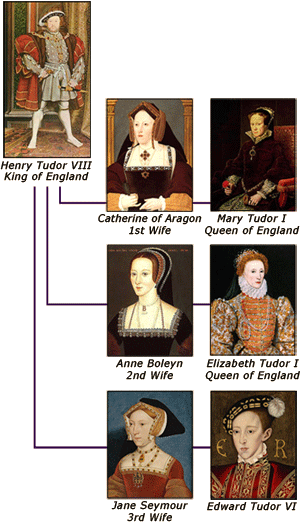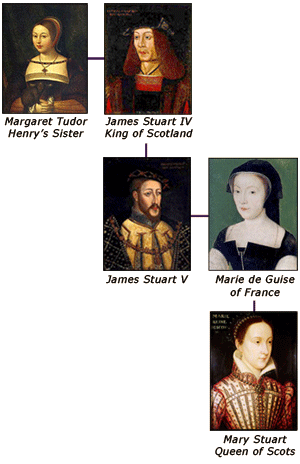So, what about these Tudors, and how does Mary Stuart, Queen of Scotland figure in to all of it?
To begin to understand the politics surrounding Mary’s life, and the entire conflict between Scotland and England in the 16th century, we have to look back at the life of her maternal grandfather, Henry VIII.

Henry VIII, King of England
King Henry’s first wife, Catherine of Aragon, had formerly been married to Henry’s brother, Arthur. When Arthur died, it was deemed necessary for a papal dispensation to be issued, allowing Henry to marry Catherine, as she was his dead brother’s wife, and the Catholic Church prohibited such a marriage. Catherine denied that her marriage to Arthur had even been consummated, so no dispensation was needed. However, both Spain and England wanted to be sure of the legitimacy of the marriage, so permission from the pope was requested and granted. Problems soon arose in the marriage when all of Henry’s male offspring were born dead or sickly, leaving his only daughter, Mary Tudor, as sole heir to the throne of England. The King was quick to claim that God was punishing him for marrying his brother’s wife, in effect, his sister. He sought an annulment from the Pope, but when none was forthcoming, he broke with the Roman Catholic Church, and his new Anglican Archbishop of Canterbury, Thomas Cromwell, had their marriage annulled. Soon after, Parliament passed the Act of Supremacy, making the king head of the English church.
Henry soon married Anne Boleyn in hopes of producing a male heir. To Anne’s misfortune, she bore him only one surviving heir (Elizabeth I) and no male children. A plot was hatched, and Anne was beheaded for treason, so Henry could marry yet again, to the Lady Jane Seymour. This union produced Prince Edward.
Before Henry died in 1547, his sixth and final wife, Catherine Parr, convinced him to reconcile with all his recognized offspring and decree in his will the following order of succession: first, Edward; second, Mary Tudor; and last, Elizabeth. Edward VI died a sickly young man in July 1553 and Mary died in November 1558 after nearly destroying her country in a feverish and bloody attempt to turn it back to Catholicism (hence her nickname Bloody Mary). This left only Elizabeth, receiving the crown at the age of 25.

Mary I, Queen of Scotland
Into these tumultuous times, Mary Stuart was born in Scotland, the only surviving child of James V. When Elizabeth took the throne of England in 1559, she was considered the rightful queen by the Protestants. To the Catholics, however, Henry’s marriage to Anne Boleyn was illegal. In their opinion, this made Elizabeth illegitimate, and Mary Queen of Scots, Henry’s niece through his sister, the legal heir. As mentioned on the previous page, Henry attempted to wed the young Scots queen to his son Edward shortly after she was born, leading to the war now known as the “Rough Wooing”.
© 2015, Saint Andrew’s Noble Order of Royal Scots, a 501(c)(3) non-profit, educational corporation.